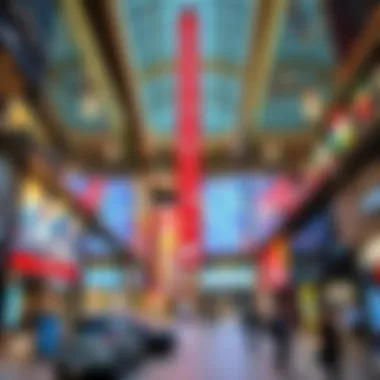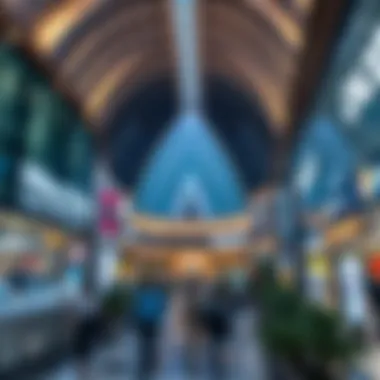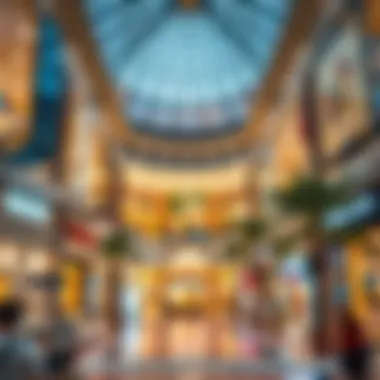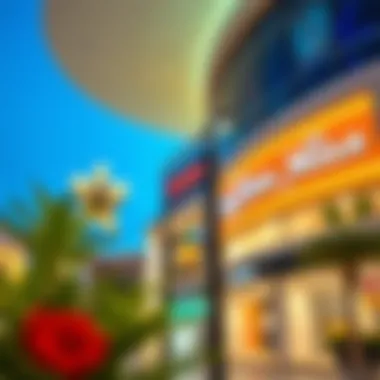Exploring Dubai's Shopping Malls: Culture and Trends


Intro
Shopping malls in Dubai are not just places to shop; they are vibrant hubs that reflect a rich tapestry of culture, architecture, and community. From glamorous retail outlets to leisure facilities, these malls offer a unique blend of experiences. Understanding the dynamics of Dubai's shopping malls can provide valuable insight for investors, agents, homebuyers, and managers alike. This guide aims to delve into the diverse aspects of the local shopping mall scene, highlighting the significance of these commercial spaces in shaping both the economy and local culture.
The history of malls in Dubai is intriguing, with roots that trace back to the city's rapid development in the late 20th century. With time, they've evolved far beyond mere shopping facilities. They're now viewed as destinations for social interaction, entertainment, and lifestyle activities. In essence, malls encapsulate the urban spirit of Dubai, making them integral to its identity.
Additionally, as the retail landscape transforms, staying ahead of trends and understanding patterns will be crucial for anyone looking to engage in this sector. Over time, the malls have adapted to cater to both locals and expatriates, offering diverse experiences tailored to varied tastes. One could say, they are a melting pot of cultures where shopping transcends the mere purchase of goods, becoming a socio-cultural experience.
This guide will navigate through multiple dimensions, examining market trends, investment potentials, and what makes each shopping mall unique. Whether you're an investor looking for opportunities or a visitor wanting to know where to find the best experiences, this narrative will offer substantial depth and insight into Dubai's local shopping malls.
Preface to Shopping Malls in Dubai
Shopping malls in Dubai have become more than just places for retail; they are bustling hubs of culture, leisure, and social interaction. As the city continues to evolve into a global metropolis, the significance of these shopping complexes extends well beyond mere transactions. They serve as landmarks, integrating lifestyle with shopping, thus shaping the social fabric of the community.
From the extravagance of the Dubai Mall to the eclectic vibe of City Walk, each mall tells its own unique story. Understanding the role of these malls provides insights into the aspirations and lifestyles of both locals and expatriates. They offer a blend of high-end brands, local boutiques, and international cuisines, catering to diverse tastes and preferences. This is relevant not just for shopping but for forging connections among residents and visitors alike.
Benefits of Shopping Malls in Dubai
Shopping malls bring forth multiple benefits that resonate deeply within the local economy and society:
- Economic Growth: They boost local employment opportunities and contribute substantially to the GDP.
- Tourism Magnet: They attract tourists, enhancing Dubai's reputation as a global shopping destination.
- Cultural Exchange: Malls often feature events that showcase local culture, thereby promoting community bonds among different nationalities.
- Amenities and Services: Many malls provide entertainment options—like cinemas, aquariums, and indoor skiing—that enhance the overall experience for visitors.
Considerations about Shopping Malls
While the glitz and glamour are undeniable, there are important aspects to consider:
- Sustainability: As the world becomes more environmentally conscious, the challenge lies in balancing luxury with sustainable practices.
- Changing Retail Environment: With the rise of online shopping, how malls adapt to maintain relevance is crucial.
Shopping malls in Dubai exemplify a confluence of tradition and modernity. They reflect not only consumer behavior but also the aspirations of a city that thrives on innovation and diversity. Understanding this environment is essential for investors, real estate agents, and anyone else diving into the intricacies of the market. Navigating these monumental spaces is not just about shopping; it's about experiencing the heartbeat of the city.
Historical Context
Understanding the historical context of shopping malls in Dubai provides a vital backdrop to their current role in society. Malls have transformed from mere shopping hubs into vibrant community centers, serving diverse functions that reflect the city's evolution. This section will discuss how the past informs today’s retail landscapes, giving depth to our comprehensive guide.
Evolution of Retail Spaces
The journey of retail spaces in Dubai is nothing short of remarkable. Initially, markets were more localized, packed with small, individual sellers hawking their goods without the structured environment we see today.
As the city began to develop in the latter half of the 20th century, so did the concept of retail. The first significant mall to grace the Dubai skyline was Shopping City, opened in 1995. It marked a shift towards larger, multi-level shopping complexes designed to cater to a growing population and an influx of tourists. Today, massive structures like Dubai Mall and Mall of the Emirates epitomize this evolution, serving as landmarks as much as shopping destinations.
- Barriers were broken down: Retail became more accessible, as these malls offered a range of international brands that local souks could not.
- From products to experiences: The focus has morphed from selling products to creating experiences, aligning with a global trend where malls serve as entertainment venues, thanks to movie theaters, gaming zones, and themed attractions.
This evolution speaks volumes about how shopping malls have not only adapted to consumer demands but have also anticipated future trends, effectively re-shaping the retail landscape in Dubai.
Cultural Significance of Malls
Shopping malls in Dubai are more than just places for commerce; they provide insight into the culture and identity of the region. Their significance can be understood through various lenses:
- Social Integration: Malls offer a common ground that bridges various cultures and backgrounds in this cosmopolitan city. They are venues for social interaction where people gather, making them vibrant centers of community life.
- Cultural Showcases: Many malls include elements that celebrate local culture, from art exhibits to traditional music performances, blending modernity with heritage.
- Culinary Diversity: Malls are hotspots for food lovers, offering immersive culinary experiences that represent both local and global cuisines. This not only serves the palate but also introduces one to cultural nuances and lifestyle choices of different communities.
The presence of shopping malls in Dubai symbolizes the city’s rapid growth and adaptability, showcasing a lifestyle that embraces both commerce and community.
In summary, the historical context surrounding shopping malls in Dubai helps us understand their multi-faceted role in contemporary society. They have evolved from individual shopping sites to complex social hubs, contributing significantly to the local economy and community fabric.
Architectural Design and Features
The architectural design and features of shopping malls are vital components that shape the shopping experience in Dubai. These structures are not merely edifices of brick and mortar; they are experiences that invite consumers into a different realm of retail and leisure. A well-designed mall can enhance foot traffic, elevate shopping experiences, and contribute significantly to local culture. Given Dubai’s unique blend of tradition and innovation, the architecture of its malls reflects these components and speaks to the broader narrative of the city's development.
Notable Architectural Styles
Shopping malls in Dubai exhibit a variety of architectural styles, merging contemporary designs with traditional elements. One iconic example includes the Mall of the Emirates, recognized for its towering structures and aesthetic that blend modernism with glimpses of Arabian heritage. Outdoor coffee shops adorned with local motifs complement a sophisticated interior of marble and glass, creating a tactile narrative amidst consumerism.
In contrast, Dubai Mall showcases avant-garde architecture, featuring sleek lines and an expansive layout. The mall's design embraces the high-tech spirit of Dubai, highlighted by the indoor waterfall and the stunning Dubai Aquarium, which offers a glimpse into the future of entertainment spaces within retail environments.
Some malls, like City Walk, exhibit a more urban feel embodying mixed-use design principles. Here, chic boutiques coexist with apartments and eateries, promoting a vibrant community space rather than a mere shopping destination. This evolution showcases how architectural styles can be aligned with lifestyle needs, representing a shift away from the traditional mall concept.
"The architectural brilliance found in Dubai's malls does not just entice shoppers; it tells a story of cultural evolution and urban expression."
Innovative Use of Space


The innovative use of space within these shopping behemoths can be seen as an art form in itself. Many malls have reconsidered how public and retail spaces interact. For example, vertical gardens and natural light are integrated into the design to create a more welcoming environment, leveraging nature to enhance the customer experience. Such features breathe life into large spaces, making them feel less sterile and more engaging.
Additionally, some malls are experimenting with flexible layouts. Instead of static retail spaces, malls are increasingly choosing modular shops that can adapt and change over time. This ensures that the mall evolves with consumer preferences, allowing for pop-up stores or seasonal vendors, which keeps the shopping experience fresh.
Moreover, well-designed common areas, such as event spaces for entertainment or community activities, reflect a trend of inviting customers to linger rather than hurry through. Whether it’s an art installation, a performance stage, or cultural exhibitions, these spaces allow consumers to participate in experiences that go beyond just shopping.
"Malls have transformed from shopping destinations to integral community spaces, showcasing the role of architecture in shaping consumer habits and community ties."
With the architectural designs evolving, the interaction between shoppers and the environment they inhabit is becoming increasingly important. Malls in Dubai stand as a testament to this change, embodying both the functional and the beautiful in retail spaces.
Prominent Shopping Malls in Dubai
Shopping malls in Dubai are not merely places to buy goods; they are woven into the city’s cultural fabric and serve as vital hubs for social interaction, entertainment, and leisure. These malls attract both locals and tourists, offering a blend of luxury and accessibility. Each mall has its unique flair and specialty, contributing significantly to the retail landscape of the city and shaping the overall shopping experience.
Mall of the Emirates
Unique Features
Mall of the Emirates stands as a beacon of avant-garde design and diverse offerings, equaled by few others in the region. One of its standout characteristics is the indoor ski slope, Ski Dubai, which provides a rare respite from the heat, allowing visitors to indulge in winter sports in the heart of the desert. The installation attracts thrill-seekers and families alike, making it a significant draw.
Another aspect is the mall's architectural brilliance, which presents not just flat retail space but an experiential journey through its airy atriums adorned with art. This blend of leisure and luxury positions Mall of the Emirates as a prime destination for both shopping aficionados and casual visitors. With such unique features, the mall not only succeeds in appealing to varied demographics but also enhances the overall tourism draw in Dubai, marking it as an investment-worthy center.
Dining and Entertainment Options
The dining landscape in Mall of the Emirates is a veritable melting pot, featuring a medley of international cuisines that cater to all palates. From fast-food giants to upscale restaurants, the range is expansive. The highlight is undoubtedly the presence of iconic establishments like the celebrity-chef-driven fine dining venues, which elevate the culinary experience beyond mere eating to an exploration of gastronomic art.
In terms of entertainment, the mall houses a cinema complex that showcases the latest blockbusters, alongside family-friendly venues such as arcade zones and a magic indoor-themed park. These options foster a vibrant atmosphere and promote longer visits, benefiting both mall operators and retailers. The depth of dining and entertainment at Mall of the Emirates ensures that it remains not just a shopping point but a complete experience, significant for any exploration of Dubai’s retail sector.
Dubai Mall
Shopping Variety
Dubai Mall is a titan in the realm of shopping, boasting an extensive range of retail options that cater to all demographics. With over 1,200 shops, the mall is home to both high-end luxury brands and well-known high-street outlets. Shoppers can find everything from high-fashion designers to gadget retailers, thus creating an inclusive environment for diverse consumer tastes. This variety makes it an appealing destination for those looking to do serious retail therapy or simply window shop.
Additionally, Dubai Mall is recognized for having one of the largest indoor gold souks, allowing visitors to marvel at an impressive array of gold jewelry— a treat for tourists and residents alike. This unique shopping opportunity paired with brand diversity positions Dubai Mall as a key player in the economic landscape, reinforcing its necessity in any guide concerning the city’s shopping venues.
Tourist Attractions Within
Beyond shopping, Dubai Mall is home to several noteworthy attractions that enrich cultural experiences for tourists. The Dubai Aquarium and Underwater Zoo, for example, draws visitors with its magnificent marine life displays and engaging educational programs. The fountain show—a synchronized spectacle of water, music, and light—is a must-see and known for mesmerizing audiences.
Moreover, the iconic Burj Khalifa offers a seamless transition from shopping to sightseeing, as its entrance is adjacent to the mall. Visitors often find themselves capturing breathtaking photos, creating a memorable connection to the shopping experience. Such attractions not only enhance the shopping experience but firmly position the mall as a cornerstone of Dubai’s tourism strategy, enhancing its pull for both local and international visitors.
City Walk
Open-Air Shopping Experience
City Walk presents a refreshing open-air shopping avenue, providing a distinct alternative to traditional enclosed malls. It integrates urban aesthetics with retail and dining, characterized by contemporary architecture and lush landscaping. Visitors can stroll through vibrant streetscapes flanked by a mix of boutique stores and established brands; this spatial arrangement allows for a more leisurely shopping encounter, which many shoppers find appealing compared to the bustling atmosphere of indoor malls.
Moreover, the pedestiran-friendly layout encourages foot traffic and community interaction, making it an ideal spot for families and social gatherings. The open-air design is not just beneficial for shoppers seeking a unique retail experience, but it also adds value by creating an inviting zone for community events and gatherings, enhancing its relevance in Dubai's contemporary shopping narrative.
Cultural Events and Activities
Embedded in City Walk's offering are diverse cultural events that aim to engage the community. From art fairs to music festivals, the area turns into a vibrant cultural hub that promotes local art and talent. These events bring about a sense of community and opportunity for local artists to showcase their work, which is especially appealing to residents.
Additionally, seasonal celebrations, such as outdoor movie nights, promote engagement among intermingling cultures and nationalities—a hallmark of Dubai's rich diversity. By hosting such activities, City Walk not only fosters cultural appreciation but also prioritizes community well-being, making it vital for investors and developers to consider when seeking to understand the broader implications of shopping malls in Dubai.
Amenities and Services Offered
Shopping malls in Dubai are not just mere structures housing shops; they serve as comprehensive ecosystems designed to cater to diverse needs and preferences. The amenities and services they offer play a crucial role in enhancing the overall shopping experience. Understanding what’s available helps both locals and tourists navigate the retail landscape efficiently, ensuring they extract maximum value from their visits.
Dining Options
Malls in Dubai pride themselves on their varied dining choices, which range from fine dining establishments to casual eateries. The culinary landscape is reflective of Dubai's multicultural fabric. Whether it's savoring authentic Middle Eastern fare or indulging in Western favorites, the options are abundant.
- Food Courts: These bustling centers provide a wide choice of affordable eats, featuring everything from fast food to local delicacies. Popular chains like Shake Shack and Subway rub shoulders with regional favorites such as Al Mallah and Al Safadi, catering to both quick bites and leisurely meals.
- Fine Dining: For those looking to celebrate with a more sumptuous meal, places like Nobu (in the Atlantis) or the atmosphere of Galeries Lafayette at Dubai Mall present excellent as well as sophisticated culinary experiences.
- Cafes and Snack Bars: If you need a caffeine fix or just a light snack, coffee hotspots like Starbucks or local cafés offer perfect spots to relax and recharge before hitting the shops again.
In summary, diverse dining options are a cornerstone of the mall experience, appealing to a range of tastes and budgets, ensuring that no shopper leaves hungry.
Entertainment Facilities
Dubai's malls are brimming with entertainment options that cater to visitors of all ages. These include theatrical experiences, virtual reality zones, and indoor amusement parks, turning a shopping trip into an all-day affair. This entertainment factor is especially significant in attracting families and groups of friends.


- Cinema Complexes: Most major malls have state-of-the-art cinemas. These venues often feature the latest blockbusters, equipped with comfortable seating and advanced screening technology, creating a delightful escape from shopping fatigue. The Vue Cinemas at Mall of the Emirates and Cinema City at Dubai Mall are prime examples.
- Gaming Zones: Venues like VR Park at Dubai Mall offer plenty of cutting-edge gaming experiences. From thrilling VR rides to arcade games, they provide excitement for both kids and adults alike.
- Family Entertainment Centers: Places like KidZania or Magic Planet provide activities tailored specifically for children, ensuring that younger visitors have their own delightful experiences while parents shop.
Entertainment facilities add immense value by transforming malls into vibrant hubs of activity, thereby keeping foot traffic up and enhancing overall customer satisfaction.
Customer Services
The strength of customer service in Dubai’s malls distinguishes them from many shopping centers globally. Excellent service is an intrinsic part of the shopping journey, helping to create a friendly and welcoming environment.
- Information Desks: Most malls feature prominently placed information desks staffed by friendly personnel ready to assist visitors with wayfinding and services. This often includes providing maps, event schedules, and recommendations.
- Personal Shopping Services: For a more bespoke experience, many malls offer personal shopping consultations. This service helps customers navigate through a sea of choices according to individual styles, preferences, and budgets.
- Loyalty Programs: Many of the larger malls also run loyalty programs and promotions, rewarding frequent shoppers with exclusive discounts and offers. Malls like Dubai Mall have developed successful schemes that blend shopping with exciting incentives.
"Great amenities and services in malls are not just add-ons; they are essential elements that enrich the shopping journey and cultivate customer loyalty."
The complex tapestry of dining, entertainment, and customer services collectively underpins the popularity of Dubai's shopping malls, ensuring they remain key attractions for both locals and tourists.
Shopping Experience in Malls
The shopping experience in malls is essential for understanding how these complex retail environments function in Dubai. Malls are not merely structures filled with shops; they are dynamic spaces that shape consumer behavior, encourage social interaction, and foster a sense of community. Also, they play a substantial role in influencing local economic trends. The experience reaches beyond just making purchases; it encompasses atmosphere, customer service, and technology integration.
When we talk about shopping in malls, we’re looking at a multi-faceted encounter that engages all the senses. Outside a typical mall, the architectural design and the surrounding landscaping often create a backdrop of elegance and comfort. Inside, the layout invites wanderlust and exploration, as shoppers navigate through various stores, dining options, and entertainment facilities. This spatial arrangement encourages longer visits, ultimately leading to increased spending.
Several key elements contribute to enhancing the shopping experience in malls:
- Ambiance: The right lighting, music, and display arrangements can create a welcoming atmosphere. Mall designers often focus on creating a specific mood that resonates with their target audience. For instance, malls catering to families may incorporate vibrant colors and play areas to appeal to younger shoppers.
- Interactive Experiences: Many malls now integrate experiential retail spaces, including pop-up shops, events, and seasonal markets. These are designed to engage shoppers beyond traditional browsing, making the retail encounter more memorable and meaningful.
- Customer Service: High-quality customer service can turn a standard shopping trip into a delightful experience. Friendly staff, knowledgeable about their products, significantly improve the overall satisfaction, encouraging return visits.
Personalizing the Retail Encounter
In marketplaces like Dubai, personalization is increasingly becoming a focus. The ability to tailor shopping experiences allows malls to cater to the individual needs and preferences of their diverse clientele. Techniques range from offering bespoke services to targeted marketing, each aiming to enhance engagement.
The personalization of the retail encounter can take various forms:
- Curated Offerings: Utilizing data analytics, malls can identify and suggest products or services aligned with shoppers’ previous purchases or interests. This approach can lead to increased sales and customer loyalty.
- Events and Promotions: By organizing community events or offering exclusive promotions, malls can create a sense of exclusivity and connection with their patrons, fostering a loyal customer base.
Role of Technology in Retail
As technology permeates almost every aspect of daily life, malls are also evolving to incorporate modern advancements. This isn't just about presenting more products; it's about creating a seamless experience that connects the physical and digital realms of shopping.
Mobile Apps and Loyalty Programs
Mobile applications have become valuable tools for enhancing customer experience. By providing essential features like store maps, current promotions, and event notifications, these apps act as personal shopping assistants. They allow users to test the waters of the shopping experience from the comfort of their homes.
Key characteristics of these mobile apps include:
- Real-Time Updates: Shoppers can receive instant alerts on sales, helping them make timely purchasing decisions.
- Loyalty Systems: Many malls utilize loyalty programs integrated into these apps, encouraging repeat visits through rewards and exclusive deals. This approach creates a mutually beneficial relationship, retaining shoppers while driving sales.
"A well-designed app does not just sell; it connects, engages and retains customers, making them feel like part of the retail journey."
However, it’s worth noting that the reliance on technology can have drawbacks, such as the potential for user privacy concerns and a digital divide that may exclude some patrons.
Online Shopping Integration
The rise of online shopping has prompted brick-and-mortar retailers to rethink their strategies. Many malls are now bridging the gap between online and offline retail through seamless integration that caters to the consumer's evolving preferences.
With this integration, shoppers are not limited to the physical offerings within the mall. Notably, customers can browse online and choose to pick up their items at their convenience, which merges the best of both worlds.
The unique features of this integration include:
- Click and Collect Options: Allowing for faster fulfillment of online orders by enabling customers to retrieve their purchases directly from stores.
- Omnichannel Shopping Experiences: Encouraging customers to interact with brands across multiple platforms ensures a cohesive brand message.
While these innovative approaches are beneficial, challenges remain, particularly in addressing inventory management and ensuring a smooth transition for customers between digital and physical purchases.
In sum, the shopping experience in malls is increasingly becoming a personalized and technologically enhanced encounter, which uniquely positions them within Dubai’s vibrant marketplace.
Strategic Locations of Shopping Malls
The strategic location of shopping malls plays a pivotal role in shaping the retail landscape in Dubai. A mall's position can greatly influence its foot traffic, accessibility, and overall success. In urban areas, where each square meter is valuable, the placement of these commercial hubs is not merely an afterthought but a well-calculated decision.
Benefits of Strategic Location
A prime location boosts visibility, attracting customers who might not otherwise visit. Malls situated near major transit points, such as metro stations and bus terminals, gain a competitive edge. This accessibility encourages spontaneous visits and allows shoppers to integrate their mall experience into their daily commutes. A significant proportion of visitors may arrive via public transport, so proximity to transport links is crucial.
Moreover, when malls are located near residential areas or within growing communities, they are more likely to see steady patronage. Residents will favor a shopping destination that is convenient and easily accessible, allowing for regular foot traffic which is beneficial for business.
"A mall is not just a place to shop, but a community hub that reflects the urban fabric of its location."


Accessibility and Transport Links
In Dubai, accessibility of shopping malls can’t be overstated. The city is renowned for its well-organized public transport system, which includes the Dubai Metro, buses, and taxis. A mall that is easily reachable enhances visitor convenience and increases footfall.
The Dubai Mall, for instance, has direct access to the Burj Khalifa Metro Station, making it an ideal stop for consumers and tourists alike. Good transport links enable shoppers to enjoy an uninterrupted shopping experience without the hassles of parking or traffic congestion.
- Metro Stations: Connecting malls to various points of the city.
- Buses: Regular routes add to the connectivity, particularly for areas less served by the metro.
- Cycling Paths: Some malls in Dubai are beginning to incorporate bike-sharing stations, catering to eco-conscious consumers.
Positioning within Urban Development
Malls also serve as key components in the broader urban development strategy of Dubai. When planning new residential or commercial areas, developers often position malls as anchors that bring life and vibrancy to neighborhoods. This positioning can not only enhance the amenities available to local residents but also uplift the surrounding real estate values.
Examples of Malls as Urban Anchors
- City Walk: It embodies a mixed-use development that fuses shopping, dining, and leisure in an urban setting. This mall is designed with pedestrians in mind, making it feel more integrated with the city rather than isolated.
- Mall of the Emirates: By situating itself strategically, it paved the way for further urban development in its vicinity, resulting in an increase in high-end residential apartments and office buildings.
Trends Influencing Mall Development
The realm of shopping malls is constantly evolving, particularly in vibrant locales like Dubai. Recognizing the shifts in consumer behavior, technology, and social preferences is crucial for anyone wanting to understand the future of retail spaces. These trends not only shape how malls are designed and operated but also fundamentally influence their role in the community and economy.
Sustainability in Design
In today's world, sustainability is no longer just a buzzword; it’s a necessity. Shopping malls are now being designed with a keen eye towards ecological impact. The integration of green technologies—like energy-efficient lighting, solar panels, and rainwater harvesting systems—highlights a notable shift. Developers are being more conscious about the materials they use. From reclaimed wood to recycled steel, these elements not only reduce carbon footprints but also appeal to a growing base of eco-conscious consumers.
Moreover, the thoughtful architectural design can significantly impact the consumer's experience. Natural lighting and open spaces can enhance the shopping experience while reducing electricity costs. For instance, malls like the Dubai Mall have incorporated biophilic design principles, where greenery is integrated throughout the shopping environment, creating not just a shopping space but a sensory experience.
“Sustainable mall designs do more than just minimize environmental fallout; they create spaces that resonate with the community’s values.”
Community-Centric Malls
The concept of community-centric malls revolves around creating spaces that foster a sense of belonging. These malls are designed not merely as commercial hubs but as social venues where people can gather, exchange ideas, and create memories. This model recognizes that shopping does not happen in a vacuum; it is tied to cultural and social interactions.
Investors are now focused on constructing malls that host local events, farmer markets, and art exhibitions, making them integral parts of the community. This trend can be seen in spots like City Walk, where urban retail meets public art and outdoor activities, drawing families and tourists alike to enjoy a day out.
A sense of locality plays a significant role here. Malls are increasingly tailored to reflect the culture, cuisine, and artistry of their surrounding areas. The outcome is a shopping experience that feels less commercial and more personal.
Integration of Workspaces
The lines between work and leisure are blurring, and shopping malls are adapting to this change. The integration of workspaces within malls allows consumers to combine shopping errands with productivity. This trend is becoming more prevalent with the popularity of co-working spaces that offer amenities like fast Wi-Fi, meeting rooms, and comfortable seating areas.
Malls are becoming one-stop shops where one can finish a work project, enjoy a meal, and do some shopping without the need to travel to multiple locations. This holistic approach to retail and work caters to the lifestyles of modern consumers, especially expatriates and locals who value convenience.
In summary, as the urban landscape continues to change, shopping malls must stay ahead of the curve. These trends emphasize sustainability, community engagement, and integration of workspaces to enhance the shopping experience while also fulfilling a broader role in society. Adjusting to these trends is essential for mall owners and operators who wish to stay relevant in a competitive marketplace.
Impacts of Malls on Local Economy
The influence of shopping malls stretches far beyond mere retail; they serve as economic engines that can revitalize local communities. Understanding the impacts of malls on the local economy is essential for a comprehensive grasp of their role in Dubai. These large complexes contribute significantly to employment, tourism, and urban development. In an environment where global competition is fierce, the ability of malls to drive economic growth cannot be understated.
Employment Opportunities Created
One of the most straightforward impacts of shopping malls is the creation of employment opportunities. They don't just provide jobs directly within stores but also indirectly through support services, including cleaning, security, and maintenance. This unique blend of employment options makes them crucial for the local workforce.
- Diverse Job Roles: From retail sales associates to administrative positions, malls attract a wide range of applicants. Typically, these jobs require varying levels of skill and experience, providing opportunities for both entry-level workers and seasoned professionals.
- Stable Employment: Many individuals in Dubai find stable jobs in malls that can serve as a starting point for professional growth. This is especially vital given the competitive job market, where stable employment options can sometimes be scarce.
- Community Impact: More jobs mean more disposable income in the community. As local workers spend their earnings, this reinforces the economic cycle, benefiting local businesses outside the mall ecosystem.
"Shopping malls are not just retail space; they are communities that create economic vibrancy."
Attracting Tourism
Malls in Dubai are also major players in the tourism sector. Their architectural grandeur, diverse shopping options, and unique experiences draw in millions of visitors every year. This aspect not only elevates the mall itself but also influences the broader local economy.
- Destination Shopping: Tourists often regard visiting malls as part of their Dubai experience. Major shopping centers like the Dubai Mall are strategically designed to offer cultural attractions, luxury shopping, and entertainment.
- Cultural Exchange: Tourists bring in different cultural perspectives that can enhance local businesses. This isn't limited to shopping; dining, leisure activities, and even local crafts receive a boost as tourists engage with community offerings.
- Revenue Generation: In addition to increasing foot traffic, malls help generate significant revenue for local economies through sales tax and other business-related taxes. This additional revenue can be invaluable for community services and infrastructure.
By driving both employment and tourism, shopping malls in Dubai stand as important pillars of the economy. They foster job creation while serving as attractions that draw tourists and locals alike, underscoring their role as vital components of the urban landscape. For stakeholders in the investment and real estate sectors, understanding these dynamics can be invaluable in decision-making processes.
Finale
In wrapping up our exploration of shopping malls in Dubai, it’s evident that these urban spaces serve more than just retail purposes. They stand as cultural landmarks, reflecting the unique blend of traditional Emirati heritage and modern global influences. Local shopping malls have transformed into social hubs, catering not only to the shopping needs of residents and tourists but also providing a platform for cultural exchange.
The economic implications of these malls extend profoundly into the community. By generating significant employment opportunities, they bolster the local economy, attracting diverse investments that can foster further urban development. Mall establishments, such as Dubai Mall and Mall of the Emirates, attract millions of visitors yearly, showing their potential to stimulate tourism and encourage spending.
Moreover, as we highlighted throughout this guide, architectural designs of these malls illustrate an innovation that merges functionality with aesthetic appeal. This approach not only enhances the shopping experience but also reflects a commitment to sustainability and community engagement. The evolution towards community-centric malls illustrates how retail spaces are adapting to meet the needs and expectations of modern consumers.
While we discuss the critical role malls play in urban landscapes, it’s also essential to consider the balance of retail with other community needs. As shopping behavior shifts towards e-commerce, the physical mall experience must continue evolving. This may involve integrating leisure, workspaces, and digital shopping solutions, addressing modern consumer's expectations seamlessly.
The importance of recognizing the multifaceted nature of shopping malls cannot be overstated; they encapsulate the economic vitality and sociocultural dimensions of urban life.
For more insights on urban development and design trends, you may explore resources like Wikipedia, Britannica, or community discussions on Reddit.
Also, consider looking into government sources that provide valuable data on economic impacts, such as *.gov.







